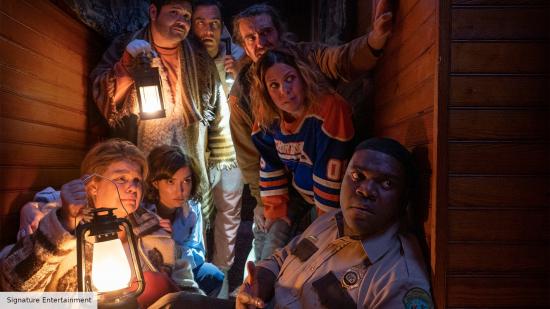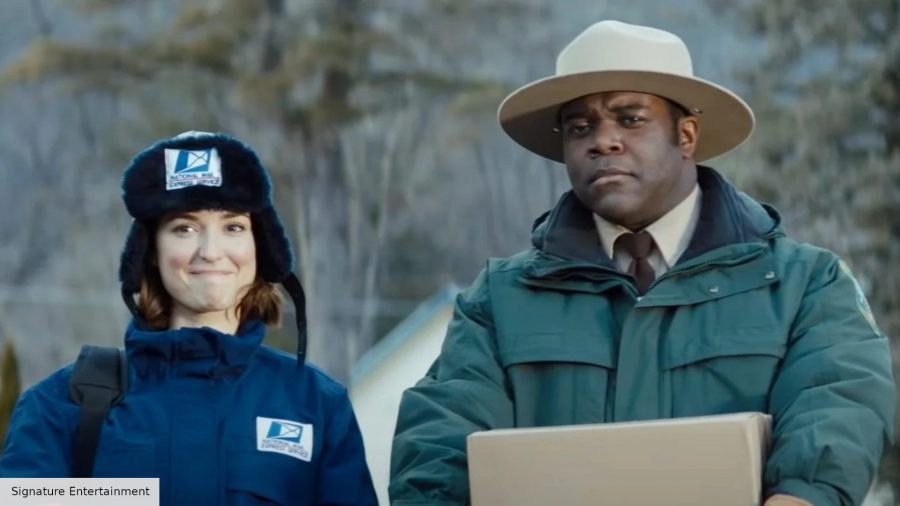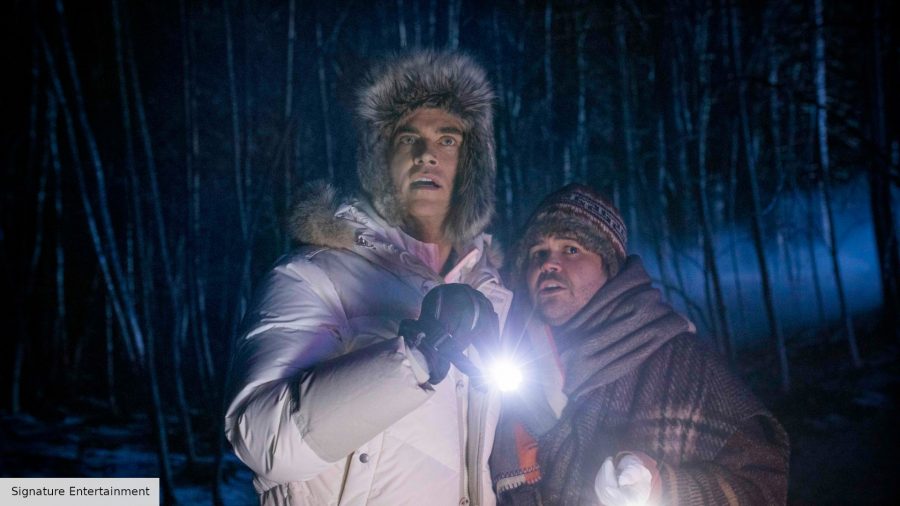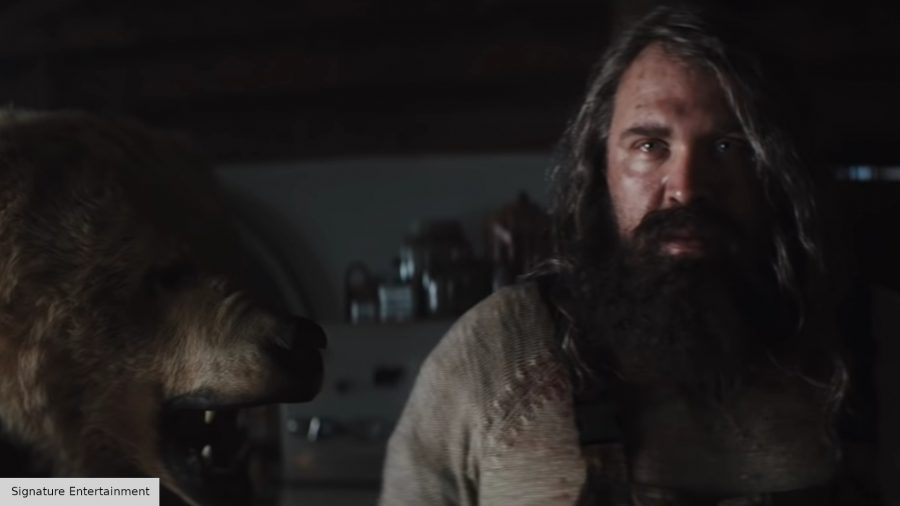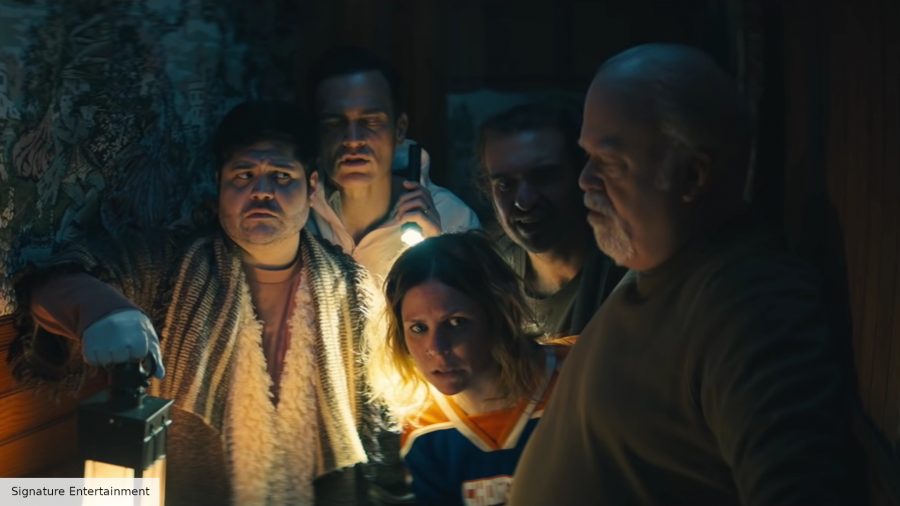Sometimes you want a good murder-mystery, sometimes you want a horror movie. Werewolves Within is a small-town whodunnit that offers both. The second directorial effort from Josh Ruben carries the scares, comedy, and bad weather from his debut, Scare Me, but adds a bigger cast, and monstrously hairy killer to the mix.
Co-produced by Ubisoft, and based on the social deduction game of the same name, Ruben’s feature draws on a number of influences, ranging from Clue and Fargo, to Edgar Wright’s Cornetto trilogy. Flanked by Mr Rogers quotes, Sam Richardson and Milana Vayntrub head up a comedic ensemble that carries us through what turns out to be one stressful blizzard.
Out now on VOD in the US, and with a UK release imminent, we got the chance to pick Ruben’s brain about what is absolutely one of the better videogame movies, low bar as that is to cross. We chatted to Ruben about incorporating Wright’s style of editing, capturing the cosy feel of the genre, and finding the right location on a budget.

TDF: Easy question to start with – can you tell me a little bit about how this movie came together for you?
Josh Ruben: Well, the producers at Vanishing Angle saw my first film Scare Me, and then they basically thought I was somehow talented enough to pitch on a bigger movie also about people snowed in at a cabin during a blizzard. So, I read Mishna’s script and loved it, and I pitched on it, I articulated how I would shoot it and, kind of, casting choices and the like, and here we are.
On the note of Scare Me, I know your character in that movie writes a story about werewolves. Were they on your to do list in terms of monsters you’d like to make a movie out of?
I was always interested in werewolves, but werewolves were also the ones that always scared the hell out of me. Monster Squad was the first one, I think, that really, really freaked me out. That werewolf is fantastic, and you can see the terror and trauma and the human being in the actual actor before he turns. That always scared me, there was a very cosmic dread about that, at least that storyline in that movie that felt very real.
Screams to stream: The best horror movies on Netflix
And Silver Bullet as well, Silver Bullet was terrifying. So yeah, I’ve always wanted to – well, I can’t say I’ve always wanted to make a werewolf movie, but, I guess I didn’t think it would either be possible, or that I would ever make something about the creature that scares the crap out of me the most, you know?
I think the thing I loved about Werewolves Within the most was Beaverfield and its people. It’s just such a well-rounded, strange little community. Can you tell me about just putting together that town, how you designed it and got those characters in place?
Oh, sure. Yeah, well, I grew up in a town very much like Beaverfield. It’s not in Vermont, it’s in upstate New York, and so we actually filmed in the town that I would hang out in as a kid, Phoenicia, New York, Fleischmanns to a small degree, but I grew up also in Woodstock, New York. So mainly the story takes place in Phoenicia, which was the town outside of my town, the town 15 minutes away from the town I grew up in, and the ‘Welcome to Beaverfield’ sign is actually based on the ‘Welcome to Phoenicia’ sign, almost down to the font.
I handed that to my production designers, Bret Tanzer, and Matt Hyland, and I said, ‘Here’s the font, here’s the aesthetic, make it feel like the mountain hamlet that was my Beaverfield growing up.’ And then as far as the cast is concerned, I mean, I did everything from make a list of actors I’ve always wanted to work with like Michael Chernus and Rebecca Henderson, and then also hired Gail Keller, who’s a wonderful casting director, and her and her team brought us everybody else, essentially.
I think that there’s a really great rhythm to some of the scenes, especially when you’ve got the gang together and was there much kind of improv and riffing while you were shooting everything?
There was yeah, yeah, in some scenes more than others, for sure. I definitely allowed for it. Because our troupe is the comedic super team of super teams.
Knives Out is another whodunnit that this shares quite a bit of similarity to, and I think one of the strengths the two of them share is that they’re whodunnits with great, memorable characters. Depending on the scene, sometimes it’s more about the mystery, sometimes it’s more about the interpersonal drama. Can you discuss the two, giving us time with the characters but also making sure that things are moving forward?
Ooh, that’s a great question. So much of it was already on the page, y’know, Mishna (Wolff, screenwriter) had done so much of the wonderful work, and then I think once once the film was wrapped, it became about justifying the roles of our characters, and tensions, and Brett Bachman, our editor, and my producers at Ubisoft and Vanishing Angle, going ‘Is this enough? Do we have enough intention? Do we have enough justification to kill, justification to leave, justification for all the aforementioned?’
There was some work done in post, in ADR and otherwise, where we sort of added or filled out some of the gaps, sometimes, in some instances, a bit more expositionally than others. But it was this brilliant process.
Have a laugh: The best comedy movies
I mean, even through the pandemic, to be able to screen the film, and then to do these Zoom feedback sessions, with a wide demographic of folks and to ask them, you know, what was confusing? What was too on the nose? Did you feel like it was slow in places, that it moved faster than it should, not fast enough, etcetera, that was what helped us in this instance, barrel toward the film that it is, that was invaluable.
You were saying that most of the film was in the script from Mishna. Can you talk a little bit about, from your initial pitch, was there anything that you had to change or shift in terms of how you originally conceived the movie in your head?
Yes, most of it was, sort of, consolidation and containment. So compressing for budgetary purposes, because we were shooting out in the winter in a far out land in the Hudson Valley, called Fleischmanns, New York, near Phoenicia. And, you know, we would lose some production time every day to the crew, the commute was about 50 minutes, so we’d lose an hour in the morning, an hour in the evening, and then we have an hour or half-an-hour lunch.
So you’re losing two and a half hours a day of shooting. So it was a more compressed shooting schedule than any of us would have desired, and it was way faster than any of us could have possibly planned for. So in order to set us up for success, yeah, we contained more extravagant sequences to make them a bit more contained, it was a bummer to lose some of the more extravagant scenes to that degree, but it made it a really fun challenge, bringing in more of a psychological thriller kind of a vibe, once we blow out the bigger Edgar Wright sequences and such.
I was actually just about to ask as well, in terms of your influences, Hot Fuzz feels like a movie that you can see, especially with the depth of the shots and the details and stuff. It felt like a very detail-oriented film in the same way that Hot Fuzz is, where your foreground is only half the movie, nearly.
Oh, Hot Fuzz was inordinately inspirational. I rewatched the, oh gosh, I can’t remember the title of the series on YouTube, but it was something to a degree of ‘How movies are made’, there was a Fincher one, and there was an Edgar Wright one, just on those smart edits. And actually boarding those Edgar Wright-esque stylistic transitions, rather than just like ‘Yeah, you cut to a beer sliding across the table’, which is what I did my first film.
Opposed to moving the camera with a certain object and then panning into it, matching camera movement to make it all work. I wanted to be really intentional and level up as much as we could on our limited budget to make that style pop. So yeah, Hot Fuzz was definitely a comp from the get go, as was Arachnophobia, as was Fargo and as was Jaws, you know?
You were talking about budgetary restraints, and I think the movie, especially in the back half, gets this kind of very isolated, almost gothic feel to it, and you were shooting during winter. I’m wondering, can you talk about just creating that kind of closed in atmosphere, with the blizzard and everything?
Sure, I mean that part of it is the location, the location of Beaverfield Inn, and even Emerson’s house proper, those are characters in and of themselves, the locations, and that’s the key. You want to walk into a location and feel like you’re not just looking at white walls, unless that’s what the emotionality of your sequence needs.
So it’s hugely important to find a location like we did in Spillian, which is a bed and breakfast out in Fleischmanns, New York run by two wonderful human beings Lee and Mark. You can have your wedding there! But we did walk in and it felt like a parlour room that felt like a location in Clue.
Supernatural without the scares: The best fantasy movies
With a location that dim or that full of character, then you can imbue those John Carpenter-like shadow. Then you can make the fire light bounce off the dim walls and recess into the dark and, you know, test what the moonlight looks like on those walls. That’s a piece of how to make it feel small, shooting on location is hugely helpful but you just have to find the right location.
Just to go back to the humor of the piece a little bit. There’s some real slight self-awareness, some moments where it seems like characters are stopping this before breaking the fourth wall. Can you talk straddling that line of self-awareness in the comedy?
I think again, using Shaun of the Dead and some of Edgar Wright’s work as a comp without getting caught being too stylistic, like there’s no moment when any one character looks down the barrel of the lens, short of maybe Finn’s moment after what brings his binoculars down.
But there’s nothing that’s purposefully wall-breaking, because I still did want an element of groundedness to this, you wanted people to kind of be nervous for Finn and for sesily, and for everyone who’s holed up in this scary place during this storm, you wanted people to feel for them. And I wanted the bumps in the night to freak people out.
So yeah, I suppose it’s just being a barometer for what scenes are appropriate to take a little bit bigger, like the scene when basically half the town is investigatory about Janine, and sort of postulating and percolating and theorising. That felt a little bit bigger than perhaps the scene in Emerson Flynn’s cabin, which I wanted to replicate the projection scene in Zodiac, you know, when they’re trying to get out of the house and all the projectionist does is walk up to the door and unlock it.
Yeah, for sure. That was funny. I knew that was going to be a little turn, but I didn’t expect it to be that simple.
Yeah!
This is based on a videogame. And I’m wondering, what were some aspects of the game that you felt were essential to bring into the film?
The spirit, just that finger-pointing spirit, the questioning of each other’s intentions and that questioning, private justice spirit. That was the most important thing, certainly to Mishna. And then for me, there were some easter eggs and physical easter eggs from the game itself.
You know, there’s a giant giant book in the game almost like a key, a book of devices to use to help with the social deduction of it all that exists in the Beaverfield on Janine’s welcome desk, as does the gnarled tree-stump table that everyone sits around when they’re all pointing fingers. That’s actually in the game and that’s in the film, that was really important to me.
And then otherwise, it’s some lighting stuff, some more stylized lighting than not, but it’s mostly spirit. I mean, that was a wonderful thing about Ubisoft, the studio was like, ‘Just make it good, just make a good movie.’ With it, you know, the nods. That’s not what’s gonna make it good. That’s not what’s gonna make people watch it again and again.
Just on that note, of this being a videogame movie. There’s often this talk of ‘Oh, how do you make a good videogame movie?’ This seems to take philosophy of just make a good movie, and the rest will follow. Do you think that studios maybe get a little bit obsessed with that idea of ‘Oh, if we’re making a videogame movie, it has to be this and this’, whereas if you just sit down with a good story, and good characters and go from there, you’re probably better off?
I think that was the case before, absolutely. I think as folks were dipping their feet in, they knew that it was enough to just make it look cool. just to make awesome creatures and awesome characters with a badass muscled protagonist, that was enough to get butts in seats. And to a great degree, what we want sometimes is that pure escape, and that sometimes can be enough. I think these days we’re getting desensitized to twists and turns and explosions.
KABOOM! The best action movies
I mean, even with the Fast and Furious franchise, it’s now so self-aware that it’s fun to go and see how self-aware it is, and it’s eventually going to become a live action Super Mario Bros. Like, they’re basically jumping really high and flying really high and flying anything and driving anything, and able to withstand any amount of pain.
And that’s, in a way, a testament to the evolution of where we’re all at, and I think that’s the brilliance of those movies. But yeah, you know, as far as this is concerned, it’s a wonderful thing about making independent film, even though it’s a bigger film than most independent films, but it is still independent, it’s story first and character first and that’s why people return to watch certain things, and also sequences, and just the feel of it.
You know, I hope this is the midnight movie, the slumber party movie that we all loved and watched when we were kids, you know. I hope this is another generation’s Gremlins or Monster Squad, something that feels like that comfort genre watch.
Just two more questions for you. The movie starts with a Mr. Rogers quote, and there’s this neighborly language throughout the screenplay. Was that part of your pitch? Or was it just an idea you came up with?
I can’t quite remember what the evolution of it was, I think it came out through the second tier of the scripting process. As far as I recall, it might have been mentioned in Mishna’s first draft, some mention of Mr. Rogers, but then we really leaned into it as far as Finn’s character arc and who he probably looked up to as a kid, like his hero.
And so that became just more conversation and more theme and allegory and pulling apart the theme of community and bringing folks together in the light. But also the Murphy’s Law of that, of humanity, where for every Mr. Rogers, you also get a terroriser, a mauler, a werewolf.
Unfortunately, we will never all hold hands across America or hold hands across the world, there’s always going to be a few Jokers to the Batmans, that’s just the way it’s always going to be. Where there’s dark, there’s light, and vice versa. So with the Mr. Rogers stuff, too, I mean, especially with the quote.
We found that once we started introducing that into Finn’s character, and introducing that theme, and those exchanges, that if we added the quotes in the beginning with the Sam Raimi-esque sting, and then introduced ‘The Phantom Strikes Again’, like a cute song, which then brings us over these gnarled tree in the dark, then there’s no question what kind of movie you’re buckling up for. We wanted to make sure people knew, the moment the movie opened, what the tone of it was.
Sure, and I think they do. And just one last question for you, theatres are reopening around the world and I’m just wondering, is there a particular cinema or theatre that you’re looking forward to attending, or catching a movie at that you weren’t able to because of lockdown?
Oh man, well Alamo Drafthouse was my last one in with The Invisible Man. And Alamo Drafthouse will be my next one, perhaps in Los Angeles to see, if not Werewolves Within with a crowd of strangers, which I’m dying to do, it will be to see Zola, my friend Janicza Bravo’s movie, which I’m dying to see.
Awesome, awesome. Dude, thank you so much for your time, and best luck with the movie.
Thanks Anthony, wonderful talking to you.
Werewolvves Within will be available on home media in the UK from July 19.
